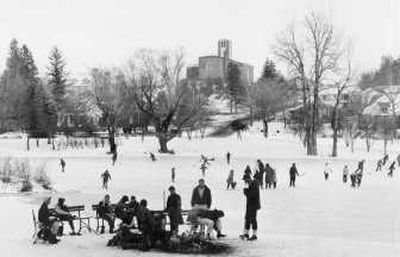Landmarks: Cannon Hill pond has industrial past

Sometimes a pond is just a pond. And sometimes it isn’t.
The pond at Cannon Hill Park on Spokane’s South Hill is one of the latter. While it looks like a lovely little body of water, a perfect scenic backdrop for a picnic in the park, with all the ambience that a gentle little lake should have, it actually has an industrial past.
Back in the 1880s, a deposit of clay was discovered at the site, which led to the creation of a brick-making operation there, lasting into the early 1900s when the clay ran out. The owners moved the plant to Clayton and opened another in Springdale, which became the basis for the Washington Brick and Lime Co., according to a 1927 article in The Spokesman-Review.
But back when brick making was in full swing at the original site, bricks from there found their way into Spokane’s history. Many chimneys in Spokane’s stately old homes were made from bricks manufactured there, and the backing bricks in The Spokesman-Review building in downtown Spokane also originated there, according to that same newspaper story.
What was left behind when brick making ended was a pitted and scarred depression, part of a 60-acre track owned by the Adams Family Trust and represented by Charles F. Adams of Boston, according to a report prepared in 2002 by historic preservation consultant Sally Reynolds. Adams, who was a grandson of John Quincy Adams, began plans to develop the land into a residential area along with the Cannon Hill Co. They agreed to donate 13 acres – including the old clay pit area – for a park, which was originally known as Adams Park but would later be named for banker and real estate developer A.M. Cannon.
Aubrey L. White, Spokane’s Park Board chairman, requested the Olmstead Brothers landscaping firm of Boston design a park at the site. It was completed in 1910. The plan called for two large water areas including the old clay pit, with excess water from nearby Manito Park to be diverted there. There would be a stone shelter with two pergolas to frame a children’s wading pool and construction of native basalt bridges spanning the water features.
The park sprang to life and became the city’s premier skating park in the winter and wading pool park in the summer.
Cannon Hill Park is Sally Reynolds’ favorite park in the city. “It is classic Olmstead Brothers,” she said, “with its irregular shape, rolling terrain, water features and basalt bridges and shelter. There were lovely willow trees around the pond, but they were damaged and removed after the 1996 ice storm.”
The smaller wading pool on the west side of the park near 18th Avenue and Lincoln Street is gone now, as are the pergolas. The bridges now have dry ground under them. And the remaining pond is smaller, too, though it is augmented by city water to maintain a consistent water level, according to Taylor Bressler, Spokane Park’s planning manager.
Cannon Hill Park remains the serene Olmstead Brothers-designed park that it was intended to be – but its industrial history still asserts itself occasionally. Bressler noted that from time to time there have been occasional small cave-ins at the park. The resulting holes in the ground have always exposed the same things – bricks made at the site 100 years ago.